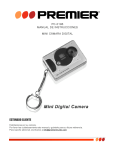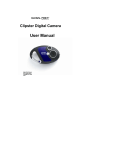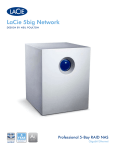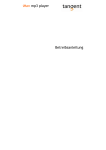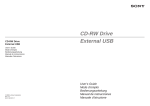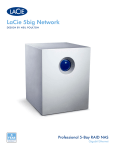Download Radio Shack USB Dual Mode Digital Camera User`s manual
Transcript
16-3830 User’s Manual Camex Digital Camera Contents 1 Introduction 1.1 Introduction to the Digital Camera 1.2 What’s Included 1.3 Parts 1.4 LCD Display 1.5 Specification 1.6 System Requirements 2 How to Use the Digital Camera 2.1 Installing Batteries 2.2 Power On/Off 2.3 Single Shot Mode 2.4 Self-Timer Mode 2.5 Video Clip Function 3 Function Operation 3.1 Deleting all photos 3.2 Deleting single photo(only deleting the last photo) 3.3 Switching to CIF format 3.4 Switching to QCIF format 3.5 Switching to frequency 50HZ mode 3.6 Switching to frequency 60HZ mode 3.7 Switching to compressed mode 3.8 Switching to non-compressed mode 4 Installation of the software 4.1 Installing DC driver 4.2 Installing PhotoImpression 4.0 4.3 Installing VideoImpression 1.6 5 Uninstalling the software 6 Downloading photos and video 7 PhotoImpression 4.0 8 VideoImpression 1.6 9 Video conference 10 Safety notice -1- 1 Introduction 1.1 Introduction to the Digital Camera This pen-shaped digital camera is easy to operate and carry around. Besides taking photos, it offers video clip functionality, image downloading and editing with the included software. It also serves as a PC camera when you hold a video conference via the Internet or have a face-to-face online chat with others. 1.2 What’s Included Digital Camera, Camera Stand, USB Cable, Installation CD and User’s Manual. 1.3 Parts A. Snap Button B. View Finder C. LCD Display D. Mode Button E. Battery Compartment F. Camera Lens G. Belt Clip H. USB Socket 1.4 LCD Display : Number of photos that can be taken : Power off mode : Self-timer mode : Continuous shooting mode; video clip function : Deleting all photos : Deleting the last photo : CIF format : QCIF format : 50Hz (~220v Voltage) : 60Hz (~110v Voltage) : Compressed mode : Non-compressed mode : PC camera mode -2- 1.5 Specification Electronic Coupling Element : CMOS sensor 100k pixels Memory Size : Built-in 1Mx16b (SDRAM) Image Resolution : 352*288 pixels (CIF) 176*144 pixels (QCIF) Memory Capacity : 20 (19 photos + 1 video data) (Non-Compressed Mode) (CIF); 76 photos (QCIF) Memory Capacity : 38 photos (CIF) (Compressed Mode) 152 photos (QCIF) Viewfinder : Built-in Lens : f=6.3mm F2.8 Self-Timer Delay : 10 second Shutter Speed : 1/6 second –1/15000 second Shooting Mode : Single/self-timer/continuous/ video clip Exposure Mode : Automatic White Balance : Automatic Power Save Mode : Automatic power off in 30 seconds if idle Working Voltage : AAA x 2 (1.5 X 2) / USB 5V Working Temperature : 32OF – 104OF Transmission Interface : USB Interface Revision 1.1 1.6 System Requirements - Microsoft Windows 98SE/2000/ME/XP - 125MB or above free hard disk space, 32MB or more RAM - Usable USB interface and CD-ROM - VGA or SVGA Color Monitor -3- 2 How to use the Digital Camera 2.1 Installing Batteries Slide the battery compartment cover in the direction of the arrow to remove it. Insert two AAA batteries according to the polarity symbols marked inside. Replace the cover. Note: When you use the USB cable to connect the camera with a computer, it is unnecessary to use the batteries because the camera can use the power provided by the computer through the USB interface. Warning: - Dispose of old batteries promptly and properly. - Do not burn or bury them. - Use only fresh batteries of the required size and recommended type. - Power off the camera before removing the batteries. Do not remove the batteries during use. Loss of power may cause the photos to be deleted. - If you do not plan to use the camera for a week or more, remove the batteries. Batteries can leak chemicals that may damage electronic parts. 2.2 Power On/Off To turn on the camera, press Mode Button. “ ” and “ ” appear on the LCD. Repeatedly press Mode Button (refer to 1.4 LCD Display) to select the desired mode/function. It will automatically go back to normal Mode in 5 seconds if idle. To turn off the camera, press Mode Button until “ ” appears, and then press Snap Button within 5 seconds. This camera can also automatically power off in 30 seconds if idle. Note: The camera cannot be turned off when it is connected to the computer via the USB cable. -4- 2.3 Single Shot Mode The LCD Display shows the number of photos you can take under Normal Mode. Use the viewfinder to frame the targeted object and press Snap Button to take a photo. A “beep” sound means your photo is successfully saved. When the image capacity reaches the limit, the LCD displays “ ” and the buzzer sounds a continuous beep if you press Snap. NOTE: Photos cannot be taken in low-light environments. 2 .4 Self-Timer Mode Press Mode Button repeatedly until “ ” appears to enter Self-Timer Mode. Press Snap Button to start 10 second self-timer .It beeps every second. A photo will be taken at the 10th second with a longer “beep” sound. 2.5 Video Clip Mode Press Mode Button repeatedly until “ ” appears. Press and hold Snap Button to start video clip function. It stops when you release Snap Button or the memory capacity reaches “0”. Note: Videos cannot be taken in low-light environments. -5- 3 Function Operation 3.1 Deleting all photos Press Mode Button repeatedly until” ” appears, and then press Snap Button once. With the figure on the LCD display flashing, press Snap Button again to confirm the deletion. 3.2 Deleting Single Photo (Only Deleting the Last Photo) Press Mode Button repeatedly until “ ” appears, and then press Snap Button once. With the figure on the LCD display flashing, press Snap Button again to confirm deletion. After deleting the last photo, the photo capacity will increase by one. 3.3 Switching to CIF Format Press Mode Button repeatedly until “ ” and “MODE” appear, and then press Snap Button to confirm. LCD display also shows “ ” when you turn on the camera. 3.4 Switching to QCIF Format Press Mode Button repeatedly until “Lo” and “MODE” appear, and then press Snap Button to confirm. LCD display also shows “Lo” when you turn on the camera. 3.5 Switching Frequency to 50Hz Mode Press Mode Button repeatedly until “ ” appears, and then press Snap Button to confirm. When taking photos in a room with fluorescent lighting, in countries where the AC voltage is 220V, use the 50Hz Frequency Mode. 3.6 Switching Frequency to 60Hz Mode Press Mode Button repeatedly until “ ” appears, and then press Snap Button to confirm. When taking photos in rooms with fluorescent lighting, in countries where the AC voltage is 110V, use the 60Hz Frequency Mode. -6- Note: 50Hz/60Hz is the AC voltage /frequency of different countries. 50Hz for Europe, Africa, Australia and China; 60Hz for the United States, Canada and Mexico. 3.7 Switching to Compressed Mode Press Mode Button repeatedly until “ ” appears, and then press Snap Button to confirm. If you see “ ” is displayed, it means your camera is in Compressed Mode. In compressed Mode, you can take a maximum of 38 in CIF format or 152 photos in QCIF format. 3.8 Switching to Non-Compressed Mode Press Mode Button repeatedly until “ ” appears, and then press Snap Button to confirm. If you see “ ” is displayed, it means your camera is in Non-Compressed Mode. In non-compressed mode, you can take a maximum of 20(19 photos +1 video data) in CIF format or 76 photos in QCIF format. 4 Installation of the Software Warning: Do not connect the camera to your computer during software installation process. 4.1 Installing DC Driver Put the CD-ROM into the drive, it will run automatically. If it does not run, click “Start” and “Run”, type “E:\autorun.exe” to install it manually (E:\represents your CD-ROM drive. Letter E may change, depending on the drive letter of CD-ROM on your computer). -7- - Click “Install DC Driver “and the InstallShield Wizard will guide you step by step. - Restart the computer after installation is completed. Note: If your computer system is Windows 98SE, you must set-up the program DIRECTX 8.1b at E:\Win\DIRECTX8.1b REDIST PACKAGE.EXE before you set-up the driver of the digital camera (E:\represents your CD-ROM drive. Letter E may change, depending on drive name of CD-ROM on your computer). 4.2 Installing PhotoImpression 4.0 - Put the CD-ROM into the drive, it will run automatically. If it does not run, click “start” and “Run”, type “E:\autorun.exe” to install it manually (E:\represents your CD-ROM drive. Letter E may change, depending on drive name of CD-ROM on your computer). - Click “Arcsoft Imaging Software” and choose “PhotoImpression “ for installation. - Choose the set-up language and follow the instructions of the InstallShield Wizard. -8- 4.3 Installing VideoImpression 1.6 - Put the CD-ROM into the drive, it will run automatically. If it does not run, click “start” and “Run”, type “E:\autorun.exe” to install it manually (E:\represent your CD-ROM drive. Letter E may change, depending on drive name of CD-ROM on your computer). - Click “Arcsoft Imaging Software” and choose “PhotoImpression “ for installation. Choose the set-up language and follow the instruction of the InstallShield Wizard. 5 Uninstalling the Software - You have to uninstall DC Driver, PhotoImpression and VideoImpression separately. - To uninstall, either click “Uninstall” under the software menu or use “Add/Remove Programs” function in Control Panel. 6 Downloading Photos and Videos - To download photos, connect the digital camera to your computer via the USB cable. - Open “PhotoImpression 4.0”under Windows Start Programs Menu. - Click “Get Photo” Button and select “Camera /Scanner”. -9- - Under “Select Source” menu, choose “Dual-Mode DSC (2770)”. - Click (acquire) and “My DSC “interface will pop up. - Press (download) to download photos and videos. - You can select all pictures and videos by clicking select all. You can also click on the photos and videos to select those you want. The selected items are framed in red. - To click 'My DSC' icon on PC screen will only help you to download the stored images from DSC to your PC. For Edit Image, you must through PC > Program > PhotoImpression > Edit. - Press (save) to save. Select “Save all photos” or “Save selected photos” and set the AVI frame rate. 7 PhotoImpression 4.0 - PhotoImpression is a full-featured and easy to use editing program, which adds endless fun, joy and creativity to your photos. - 10 - - To start, choose “Arcsoft PhotoImpression 4.0” under Windows Start > Program Menu. - Click “Get Photo” and select “From Folder”. Double click the photo thumbnail to choose the photo you want to edit. - Click “Edit” button to edit your selected photo. - 11 - - To learn more about the edit features, click (help) to view the help section. 8 VideoImpression 1.6 - With VideoImpression, you can edit and combine your video clips and photos quickly and easily. You can share your edited videos with friends and family via e-mail. - To start, choose “Arcsoft Photoimpression1.6”under Windows Start > Program Menu. - Click and then want to edit. to open the videos and photos you - 12 - - Drag and drop the videos and images together in the sequential storyboard. - Press help to learn more about the editing tools. 9 Video Conference - Connect the digital camera to your computer using the USB cable. - Run the video conference software, e.g. Microsoft NetMeeting. Click “Tool”, ”Option” and then “Video frequency”. Select “Dual-Mode DSC (2770)” under “Video camera property” and press “Confirm”. - You can start holding a video conference via the Internet. 10 Safety Notice - Do not connect the camera to your computer during software installation process. - Download all images from camera before the batteries are discharged, otherwise, the images will be deleted automatically. - To ensure stable performance, do not get the product wet or store it in humid environment. - 13 - FCC statement: This device complies with Part 15 of the FCC Rules. Operation is subject to the following two conditions: (1) this device may not cause harmful interference, and (2) this device must accept any interference received, including interference that may cause undesired operation. Limited 90-Day Warranty This product is warranted by RadioShack against manufacturing defects in material and workmanship under normal use for 90 (ninety) days from the date of purchase from RadioShack company-owned stores and authorized RadioShack franchisees and dealers. For complete warranty details and exclusions, check with your local RadioShack store. RadioShack Customer Relations 200 Taylor Street, 6th Floor, Fort Worth, TX 76102 04/04 Printed in China All Rights Reserved. - 14 -















